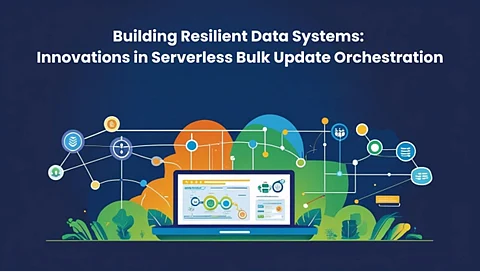

In this modern era, Vamsi Praveen Karanam, a researcher in the field of distributed systems and cloud-native computing, presents a thoughtful exploration into the architectural innovations underpinning serverless bulk update orchestration. With a focus on practical reliability and theoretical rigor, his work offers valuable insight into modern data infrastructure design. His research bridges the gap between abstract system models and real-world implementation, making it highly relevant for today’s evolving technological landscape.
Serverless computing has upended traditional assumptions about managing large scale data operations. Moving away from batch-oriented processing and static infrastructure, serverless models offer on demand execution with automatic scaling. This transition presents an opportunity to simplify operational complexity while introducing new challenges around transaction management and distributed state coordination.
At the heart of this architectural framework lie four principles: atomic update semantics, idempotent function design, state machine composition, and event sourcing. These foundational elements enable serverless systems to maintain transactional integrity in environments lacking persistent connections. By decomposing updates into independent yet coordinated tasks, the architecture ensures consistency without centralized control.
Effectively encapsulates these layers from the core principles to the orchestration and execution tiers, emphasizing modularity and fault isolation.
Serverless environments impose hard constraints: limited execution duration, lack of state persistence, and potential duplicate invocations. To address this, the architecture employs idempotent functions and checkpointing to safely retry operations. Further, the use of saga patterns forward steps with compensating rollback ensures recovery without heavy locking or serialization, critical in high volume scenarios.
One of the standout innovations is the use of event sourcing to manage state evolution. Instead of modifying current states directly, this method records changes as a sequence of immutable events. This strategy aligns well with distributed consensus models and allows eventual consistency even across network partitions. Through techniques like vector clocks and timestamp ordering, it becomes possible to reconcile distributed updates deterministically.
Evolving schemas pose real world challenges, especially when functions operate on different data versions. The proposed solution includes polymorphic access layers and schema aware transformation pipelines that support backward and forward compatibility.
To mitigate performance hits from usage spikes, adaptive throttling strategies such as partition aware routing and jittered backoff algorithms are utilized. Highlights these implementation complexities, especially the heavy lifting involved in concurrency management and throttling avoidance.
The article dissects scalability with a blend of formalism and pragmatism. Using models like Horizontal Scaling Efficiency HSE and Consistency Scaling Tradeoff CST, the system's behavior under load is quantitatively assessed. These metrics show how performance varies not just with load volume but with how tightly consistency guarantees are enforced.
Additionally, critical path analysis and adaptive parallelism enable smarter allocation of resources, avoiding bottlenecks and making full use of ephemeral compute capacity.
Serverless platforms promise linear cost scaling but reality involves cold starts, memory configuration quirks, and minimum billing units. The work acknowledges these limits and suggests capacity reservation and stepped provisioning as ways to manage costs. Cost modeling at the component level empowers architects to fine tune their systems with economic precision.
Fault tolerance in this model is not an afterthought but a core capability. With checkpoint based recovery, execution history, and idempotent processing, the system gracefully handles both logical and infrastructure failures. The strategy localizes failure to individual function instances and avoids cascading errors through circuit breakers and retry logic.
Despite its innovations, the architecture contends with significant tradeoffs: cold start delays, state size restrictions, and data locality limitations. These boundaries are explicitly acknowledged, offering transparency to architects considering serverless orchestration for critical workloads.
The infographic clearly outlines these constraints alongside empirical strengths, framing a balanced view of applicability.
This ultimate vision is forward-looking. It calls for adaptive orchestration systems that could modify execution plans by live telemetry, specialized programming models that could more intuitively express distributed logic, and deeper integration of machine learning to forecast scaling requirements or detect anomalies. Such concepts hint at a time when serverless systems would not only react but would learn and evolve.
In conclusion, this work of Praveen Karanam Vamsi forms a very strong foundation for executing massive and difficult data updates in modern cloud scenarios. By challenging the present views of consistency, performance, and cost in stateless, distributed systems, it paves the way for the next generation of resilient data infrastructure.
